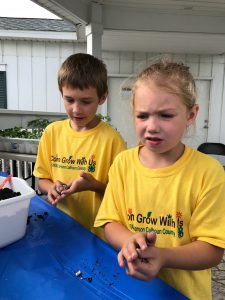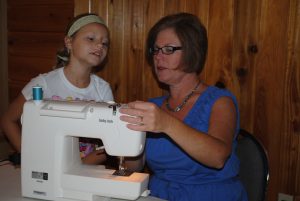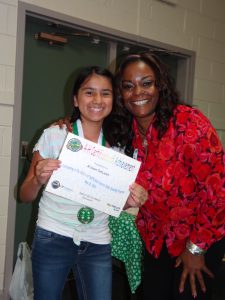by Whitney Cherry | Mar 8, 2019

Wildflower seed bombs are a great indoor or outdoor project with unlimited potential for learning.
Wildflower seed bombs are the perfect project for kids itching to get outside. Even if you don’t have a green thumb or you don’t have outdoor space or the weather isn’t cooperating, you can make seed bombs that will help beautify roadsides, vacant areas and neighborhoods.
Give Them a Toss!
These little beauties don’t get their name from any explosive properties but from the fun you have “launching” them around your yard or neighborhood. As you toss them into places that aren’t frequently mowed, you beautify your neighborhood and provide an invaluable food sources for native Florida pollinators like bees, wasps, butterflies, and more.
Even though you may be more fond of some pollinators than others, there’s no doubt we need them all. Their pollination services are critical to fruit development in many of our fruiting crops. So if you like squash, cucumbers, melons, almonds and so much more, here’s what you can do to help:
Gather Your Materials
- Air-dry clay
- Wildflower seeds
- Potting Soil
Make Your Seed Bombs
- Pinch off a small amount of air-dry clay – enough to make a ball about the size of a bouncy ball or about 1″ diameter.
- Work equal parts seeds and soil into the clay and form it into a ball.
Amounts really are up to you. More seeds = more flowers.
But, too much soil will keep the ball from holding it’s shape. If this happens, add more clay and either have a bigger bomb, or divide it into two smaller bombs.
- Store them in a cool dry place and let them dry out completely in an air-tight container until you’re ready to spread some wildflower cheer.
- Now for the fun part! Toss them where you want flowers to grow.
Things to Consider…
- The air-dry clay acts as a binder only. It’s natural, non-toxic, and when wet, it will soften and allow the seeds to grow.
- Before storing in an airtight container, allow your seed bombs out to dry completely. Even a little moisture will allow the seeds to sprout.
- Be careful when throwing your seed bombs.
- Don’t hit people, animals, or other anything else with them – just the ground.
- Throw them where areas don’t get mowed very much. Some people throw them out along roadways or in abandoned lots. If these places are mowed regularly, they won’t last long if they even get to bloom.
- Get permission if you’re throwing them in public places.
Resources
Gardening is just one of the many Florida 4-H programs. To see what programs are available in your county, contact your local UF/IFAS Extension office, or contact your 4-H Agent about starting a gardening program in your county.
by Julie Pigott Dillard | Aug 31, 2018
With so many extracurriculars available these days, parents and kids are overwhelmed with choices.
To choose the right one, know what to prioritize, says Heather Kent, associate director of the Florida 4-H youth development program, part of University of Florida’s Institute of Food and Agricultural Sciences Extension.
“The 4-H motto is ‘To make the best better.’ The research shows that kids are more likely to find success as adults when they feel confident and capable in the face of new challenges,” Kent said. “You want to find a program where kids can find their spark in a safe environment.”
So, when comparing extracurricular programs, keep this checklist in mind, Kent said.
- Does it help them do better in school?
Look for programs that complement a child’s day-to-day school work. “Each 4-H activity has an educational component to it,” Kent said. “Compared to their non-4-H peers, 4-H youth report better grades, higher levels of academic competence and an elevated level of engagement at school.”
- Does it teach them how to speak up?
Give your child a chance to express him or herself to others. “4-H alumni often say that the public speaking skills they learned in 4-H have helped them throughout their careers, no matter which field they are in,” Kent said.
- Does it include STEM?
“One of the goals of 4-H is prepare young people for the workforce, which means introducing them to STEM — science, technology, engineering and math — through hands-on projects in areas like horticulture, robotics and embryology,” Kent said.
- Does it broaden their horizons?
“The members of a 4-H club may not all go to the same school or live in the same neighborhood. Meeting people who have different backgrounds from yourself expands your worldview,” Kent said.
- Is it a good return on investment?
Some programs give you more bang for your buck. “Annual registration for 4-H is $20, and there are scholarships available. That gives youth access to a wide variety of projects and events—everything from aerospace to agriculture. If not for their 4-H membership, they might have to join several other organizations to get all the same opportunities,” Kent said.
- Does it help them explore their interests?
“Finding a passion teaches youth about delaying gratification and taking pride in their work. That’s something they take with them into their careers,” Kent said.
- Does it develop organization skills?
Choose activities that require kids to stay on top of things and plan ahead. “For a project to be successful, 4-H members know they need to stay organized. For instance, you can’t raise a prize-winning animal without a plan for how you are going to reach that goal,” Kent said.
- Is it open to everyone?
Consider whether the whole family can participate. “4-H is open to both boys and girls ages 5 through 18. There is also collegiate 4-H and adult volunteering opportunities. Unlike other programs, 4-H is something everyone in the household can be a part of,” Kent said.
- Does it introduce kids to mentors?
Having adult role models who aren’t one’s parents is an important part of youth development, Kent said. “Our trained volunteers and Extension agents form a support system for 4-H members. Knowing that another adult cares about you is a big confidence boost and helps kids feel comfortable trying new things.”

- Is it well established?
Learn about the history of the program. “4-H has been around for more than 100 years, and it’s been researched and developed through the U.S. Land Grant university system. In Florida, there are more than 200,000 youth in 4-H, and each of them benefits from being a part this longstanding, well known organization,” Kent said.
The mission of the University of Florida Institute of Food and Agricultural Sciences is to develop knowledge relevant to agricultural, human and natural resources and to make that knowledge available to sustain and enhance the quality of human life. With more than a dozen research facilities, 67 county Extension offices, and award-winning students and faculty in the UF College of Agricultural and Life Sciences, UF/IFAS works to bring science-based solutions to the state’s agricultural and natural resources industries, and all Florida residents. Visit the UF/IFAS web site at ifas.ufl.eduand follow us on social media at @UF_IFAS.
by Samantha Grenrock – Sam is a public relations specialist at UF/IFAS Communications. She loves animals, poetry and learning about science.
Shared with permission from the original author.
by Heather Kent | Sep 28, 2017
 4-H Standards of Excellence are tools to help individual members and clubs set and achieve goals and are part of our recognition model. Recognition is an important part of the 4-H experience; it helps master skills and knowledge by providing feedback on progress towards goals. Standards of Excellence is one of my favorite ways to recognize youth and clubs. Here’s how it works:
4-H Standards of Excellence are tools to help individual members and clubs set and achieve goals and are part of our recognition model. Recognition is an important part of the 4-H experience; it helps master skills and knowledge by providing feedback on progress towards goals. Standards of Excellence is one of my favorite ways to recognize youth and clubs. Here’s how it works:
At the beginning of the 4-H year, youth decide which level of recognition they would like to receive. The levels are bronze, silver, gold and emerald. To help youth decide, they should review the Standard of Excellence matrix with their parent or club leader. The matrix outlines what a member needs to do in order to achieve each level of recognition. For example, if a junior member (ages 8-10) wants to achieve the gold standard, he/she would need to plan to do the following throughout the course of the 4-H year:
- Attend at least 2/3 of club meetings (or number established by club).
- Share project experiences by giving a presentation.
- Attend three different activities
- Participate in three different activities
- Participate in three community service activities
- Participate in four different competitions / exhibitions
- Complete two project record reports
- Teach one club level activity
- Make a poster on “My 4-H Experience” or submit Building My 4-H Portfolio
 But wait, that’s not all! 4-H Clubs can also achieve Standards of Excellence. During the club organizational meeting, members can choose which type of club they want to be (bronze, silver, gold or emerald), and build those requirements into their club plan (most of the items are things that clubs would want to do anyway, so why not be recognized for it?):
But wait, that’s not all! 4-H Clubs can also achieve Standards of Excellence. During the club organizational meeting, members can choose which type of club they want to be (bronze, silver, gold or emerald), and build those requirements into their club plan (most of the items are things that clubs would want to do anyway, so why not be recognized for it?):
- Bronze club- 12/20 items on the list
- Silver club- 14/20 items on the list
- Gold club-16/20 items on the list
- Emerald club- 18/20 items on the list
Once a member or club establishes their goal, they can submit their plan to their club leader. Towards the end of the 4-H Year, the member submits their application to their leader, who signs off on it and submits it to their 4-H agent. Youth are recognized during their County Achievement Night, or Awards Banquet.
Interested in helping? We need volunteers to serve as project mentors, review/judge awards applications or help plan annual recognition programs. Contact your local UF IFAS County Extension Office if you would like to get involved.





